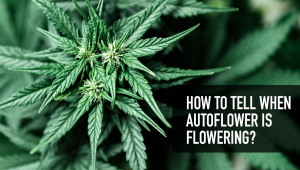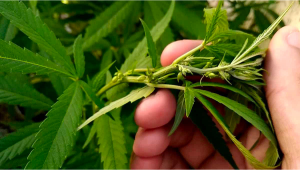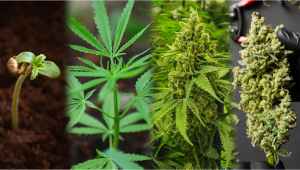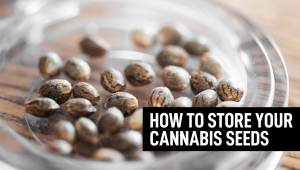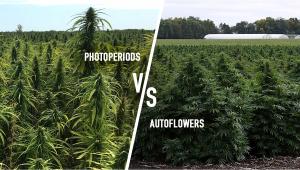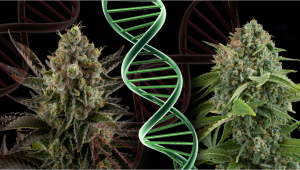How to produce cannabis seeds
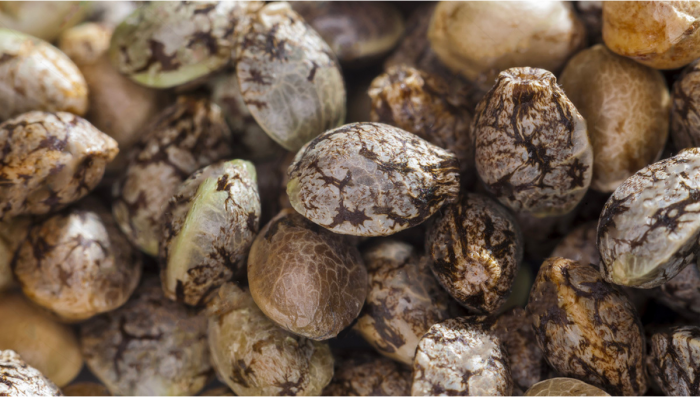
- 1. Photoperiodic cannabis
- 1. a. Regular photoperiodic cannabis
- 1. b. Feminized photoperiodic cannabis
- 2. Automatic flowering cannabis
- 3. How to make your own seeds
- 3. a. Photoperiodic regular seeds
- 3. b. Photoperiodic feminized seeds
- 3. c. Feminized and regular autoflowering seeds
- 4. Pollen collection and storage, and proper pollination techniques
- 5. In conclusion
Just like many other plants that you might enjoy growing in your garden, including a plethora of different vegetables and flowers, cannabis seeds also feature several different varieties. Known as cultivars or strains, each type possesses different traits, including the way that they flower, their size and shape, and even their effects. There are thousands of cannabis varieties available. However, all of them belong to three umbrella categories depending on the way they flower and what gender they express. When it comes to cannabis plants, feminized seeds are the most known ones. But do you know what auto and regular means?
Below, you’re going to deepen your cannabis knowledge by learning all about these groups of seeds. Then, we’re going to take things one step further and teach you how to create your own seeds at home. By the time you get to the bottom of the page, you’ll know all about the basics of cannabis breeding. Here we go.
1. Photoperiodic Cannabis
Photoperiodism isn’t unique to cannabis plants, many flowering plants sense changes in the length of night and day and use those changes as signals for when to flower. Think about it. Plants need to understand what’s happening in their environment in order to survive. While some species can deal with cold weather and even hard frosts, cannabis cannot tolerate such extremes. In order to ensure that successful growth and reproduction take place before the colder weather of winter arrives, plants are able to detect seasonal changes in light exposure; they time their expression of flowers just right so that they can disperse seeds before perishing.
Photoperiodic cannabis plants are just like that, they basically respond to changes in the light cycle. As the night becomes longer at the beginning of autumn (in nature) or when you flip to 12/12 in a grow tent, the plant receives more darkness. This causes the plant to realize that its life cycle is coming to an end and they will start to flower (females) or produce pollen (males) in order to reproduce before winter.
Regular Photoperiodic Cannabis
Outside of human tampering by way of breeding techniques, cannabis is a dioecious plant, meaning that male and female flowers occur on entirely separate plants. In contrast, monoecious plants such as cucumbers and peppers produce male and female reproductive organs on the same plant. Regular cannabis is photoperiodic cannabis that produces both male and female plants. They are called regular because they are produced the “natural way”: the pollen from the male plant pollinates the female, resulting in seeds. Back in the day, the only way to grow cannabis was with regular seeds, this way you would get half male and half females plants. There is a big difference between male and female plants, while female grows buds, male plants will only grow pollen sacs.
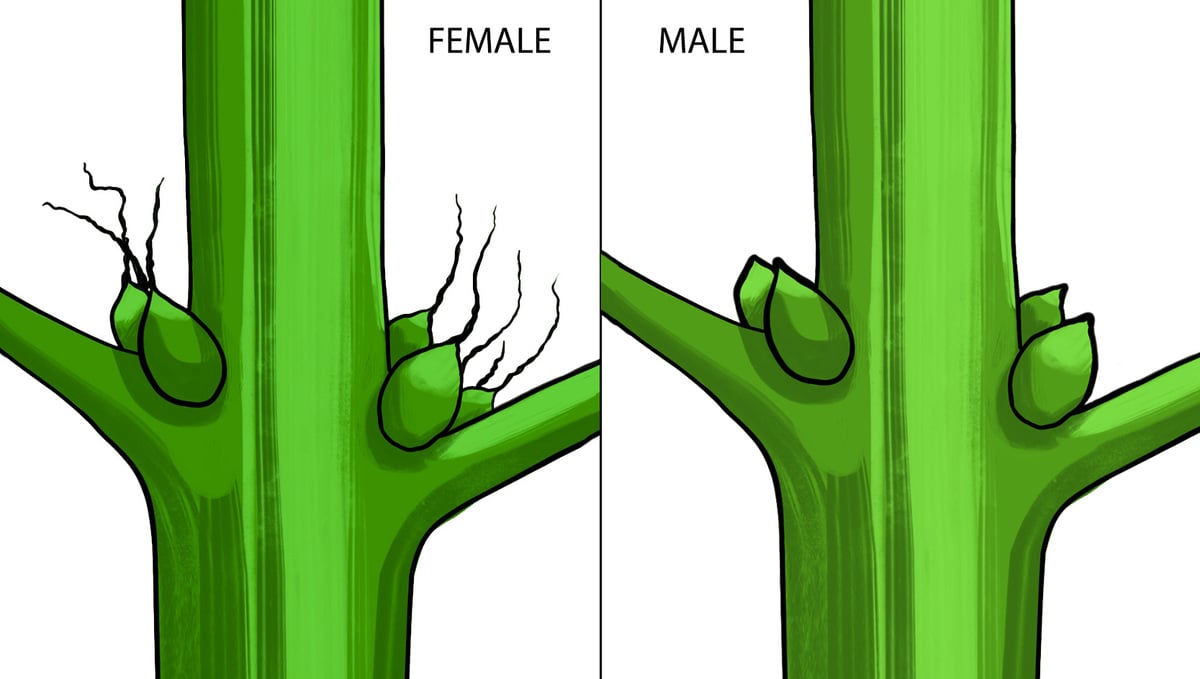
In nature male cannabis’ pollen sacs will open to release pollen which will pollinate the female flowers, this way producing seeds. But most growers that grow cannabis commercially or for their own consumption only want buds, allowing males to pollinate buds would ruin their harvest because pollination diminishes yield, so they're mainly looking for female plants. Growing regular plants comes with both benefits and disadvantages. For home growers interested in nothing but high-quality flowers, male plants can often go undetected within the growing area and pollinate female flowers. This causes female buds to go to seed and reduce resin and cannabinoid production. However, growers interested in breeding rely on regular seeds in order to grow male plants and capitalise off the precious pollen that they produce.
Feminized Photoperiodic Cannabis
To completely avoid accidental pollination and other problems related to male plants, feminized seeds were created. Feminized seeds come from the cross of two female plants, one of them is stressed so it starts producing pollen sacs, which will fertilize the other female. When you cultivate feminized seeds, the offspring will be only female plants. This takes out a lot of the unnecessary work that you can have when growing males and them not being able to use them. Ever since the boom of feminized seeds back in 1998, growers have stopped buying regular seeds for quite a bit. Nowadays most seed banks don’t even sell regular seeds anymore. With so much focus on feminized seeds, we can’t forget that regular seeds are vital for the creation of new strains.
2. Automatic Flowering Cannabis
You must already know that the characteristic that makes autoflowers an auto is they don’t need a different light cycle to enter the flowering stage. Like their name says, autoflowers start flowering automatically depending on age, and unlike regular and feminized cannabis that needs a change in the light cycle to start flowering. Autos don’t need anything else other than time to start producing buds.
But that trait didn’t come out of anywhere, it appeared as an adaptation to the environment. You’ve probably heard of Cannabis Indica and Sativa…well, the autoflowering gene comes from Cannabis Ruderalis. The Ruderalis species adapted to the extremely cold and harsh climates of Asia, Europe, and Russia. These regions have shorter warm seasons and colder temperatures. Because of this, Ruderalis started mutating from a photoperiodic plant to an autoflowering plant, to guarantee its reproduction before the temperatures reached freezing levels. Thanks to that adaptation, now we have autoflowers that take considerably less time from seed to harvest.
3. How To Make Your Own Seeds
Producing your own seeds is relatively easy if you have what it's needed but that doesn’t mean the result will be a perfect strain. The good strains or “IBLs” that most seed banks sell are strains that have been developed for years and are far into the third or fourth generation. IBL or stabilized strain means the offspring will have certain characteristics locked down. When you cross two strains for the first time the offspring can have infinite phenotypes and this is not good for commercializing.
But don’t let this put you off! If you’re new to breeding, simply creating your own seeds and growing them out to maturity is rewarding enough. However, as stated, the results vary widely. Currently, the seed market is packed full of polyhybrids (strains that are the progeny of two different hybrids). Crossing these varieties means your seeds will produce plants with many different traits and high genetic variability. While you’ll want to hone your breeding techniques and genetic starting material as you develop your skills, many breeders start off using anything they can get their hands on for their first cross.
Photoperiodic Regular Seeds
When we talk about cannabis, it’s easy to forget about male plants. Everybody nowadays is used to the beautiful flowers we all love, but it’s important to remember that male cannabis plants are just as important as females. Male cannabis plants produce pollen and are an essential element in the production of new cannabis plants. This pollen is super important in breeding cannabis as it allows breeders to create crosses with genetics from different plants and create their own seeds. For producing seeds all you need is pollen and buds. Cannabis pollen is no different from regular pollen produced by other plants. It’s a fine powder that usually has a golden yellow color and is excreted from the pollen sac on male plants.
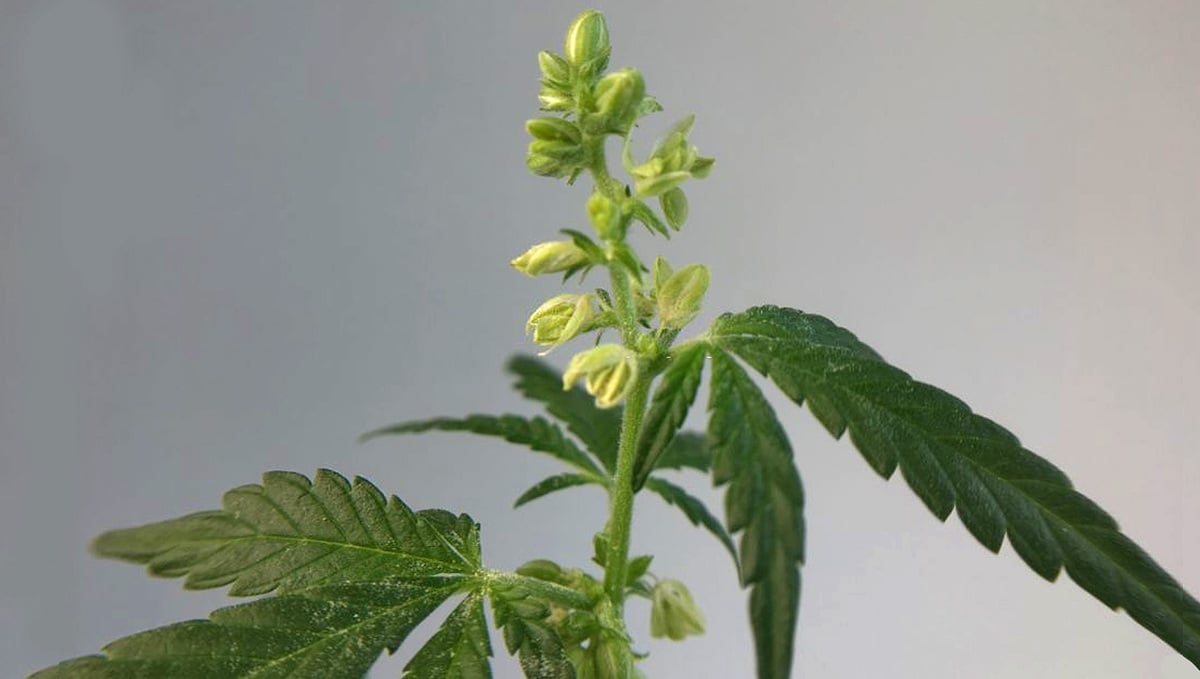
Collecting pollen is simple. You'll know when its ready to be collected when the pollen sacks are open and you see pollen floating in the air and on the leaves near them. When this happens, you can gently remove the sacs and store them in a ziplock bag, once you are ready to pollinate just release the pollen onto the buds. Another way is to simply agitate your male plants near the female plants, the pollen will stick to the buds. Pollen is used in order to pollinate female plants and create seeds. In nature, female plants get pollinated by the wind which carries the male pollen. Cannabis seeds develop in the buds about 4-6 weeks after pollination, you will see the calyxes start to round up from the seeds being inside them.
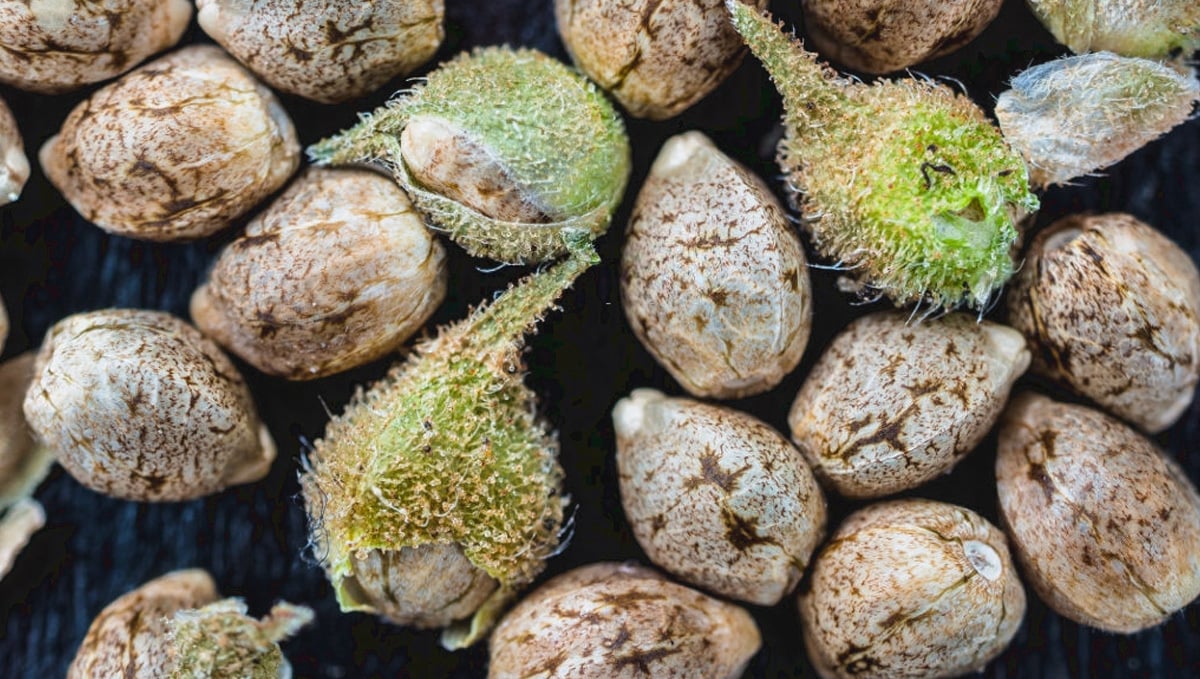
Pollinated buds look quite different from regular buds. They usually don’t have as many trichomes and are usually smaller and a lot more swollen. 4 weeks after pollination, you can start checking the buds to see if the seeds are ready for harvest by picking a couple of seeds from the bud. Mature seeds will have a hard shell and be a dark brown color, they might also have some stripes on the outer shell.
Photoperiodic Feminized Seeds
Normally, a male cannabis plant has to pollinate a female plant to produce seeds. The resulting regular seeds will contain about half male and half female seeds. The way feminized seeds are produced is the same but instead of collecting the pollen from a male, breeders will stress or spray flowers with colloidal silver, for example. This process forces the female plants to become a hermaphrodite and starts producing pollen sacs. Hermaphrodite plants are females that are halfway turned into males, this means she has both male (pollen sacs) and female (buds) parts.
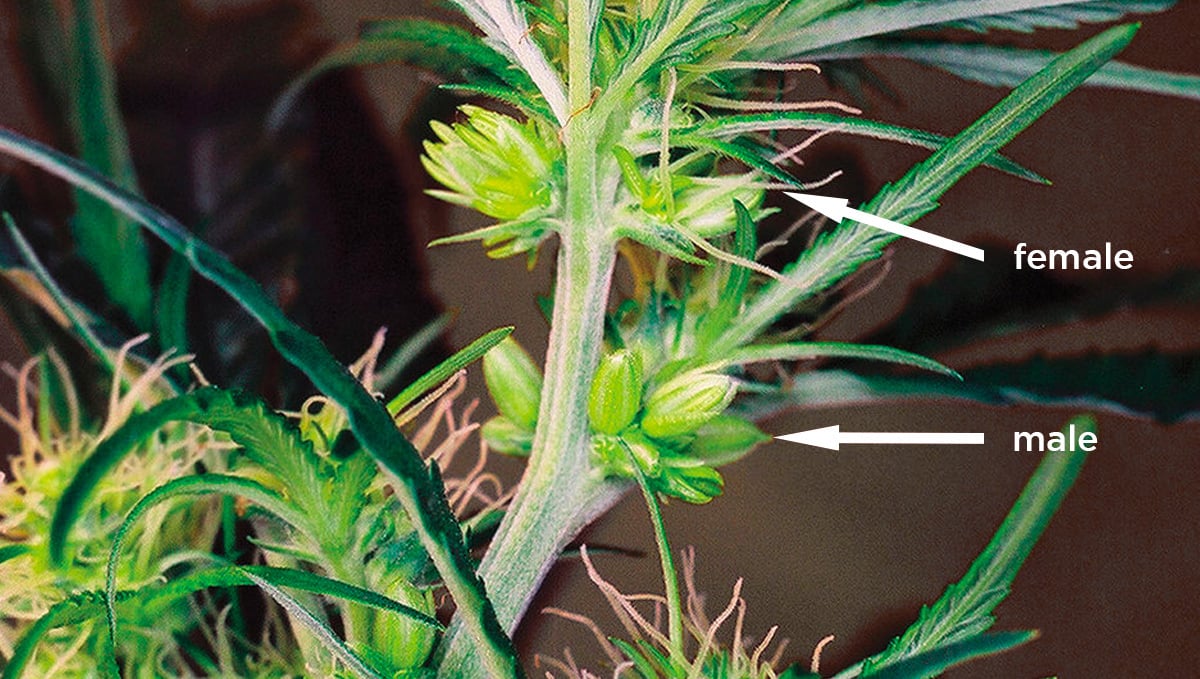
By picking out the pollen sacs and using a reverted plant's pollen to pollinate a female plant, you will have only female genes as there is no "father", this way you get feminized seeds, meaning the offspring will be 100% female plants.
Feminized and Regular Autoflowering Seeds
Regular Autoflowering Seeds
Usually, you can find regular and feminized seeds, and this applies to autoflowering seeds also. This means you can find male and female autoflowers, depending on the type of seed you buy (regular = 50% male and 50% female, feminized = 100% female). Unfortunately the high increase in the production of feminized seeds affected automatic seeds also. Although it’s not common to find regular auto seeds nowadays, they do exist. For producing regular autoflowering seeds all you need is male pollen and female buds, just like for regular photoperiodic cannabis. The process is basically the same, collect the pollen from the male and spread it on the buds, this will result in regular autoflowering seeds.
Feminized Autoflowering Seeds
The process of producing feminized autoflowering seeds is almost the same, the only difference is you will need two female autos instead of one male and one female. You will have to make one of your female autos produce pollen, either by stressing her out or spraying with colloidal silver and pollinating the other female. This will result in a 100% female automatic offspring.
4. Pollen Collection and Storage, and Proper Pollination Techniques
The process of collecting pollen from either a male or a hermaphrodite cannabis plant is a piece of cake, but you do have to be very careful if you have female plants nearby. One male or hermie plant can pollinate a whole crop if you are not alert and aware of the stage the pollen sacks are at, so always try to keep any pollen-producing plants well quarantined from any females that you want to keep seed free. The best way to harvest the pollen is to carefully remove the whole pollen sac flower head, let it dry for a couple of days to a week and then transfer the whole shebang to a sealable container or zip-lock bag. Once in the bag or container, you can give the whole thing a bit of a shake and the pollen should fall right out In terms of pollen storage, there are a few factors to take into consideration. Temperature and moisture levels are the most important things to control. Our tried and true method for at-home storage of cannabis pollen is:
- Collect the pollen and place it in a sealed container or zip lock bag.
- Add regular baking flour - about double the weight of pollen. This doesn't need to be super exact, but it helps greatly with moisture absorption and spreads your pollen out much further.
- Place the whole thing into the freezer where it can be stored for up to a year.
- Pollen hates temp fluctuations, so leave it be until you are sure you are ready to use it
When you are ready to pollinate your plant the process is again nothing more than child's play, but you have to be very careful not to spread the pollen to plants that you want to remain seedless. This can be a little difficult if the plants are rooted into the ground, but if they are in pots then the job is much safer.
Just move whichever female plant you want to produce seeds to an area well away from the rest of the crop. There are a few ways to pollinate your plant, but our favorite method is this:
- Wait until the female plant is in her 2nd or 3rd week of the flowering cycle. At this point, you should see pistils forming fully (the small white hair-like growths)
- Grab your pre-collected pollen from the freezer and let it come to room temp over a few hours
- Dip a small, fine paintbrush or Q-tip into the pollen and apply it to the pistils of the budding sites that you want to produce seeds
- We recommend focusing on the budding sites on the lower branches - the popcorn bud producing areas. These buds are usually the lowest quality in terms of smokeability and trichome production, so use these ones for seeds instead!
- Seeds usually take around 4 - 5 weeks to mature fully. A mature cannabis seed is brown in color with tiger-like stripes and a hard outer shell.
A common question asked is - how many seeds a single budding site will produce? This is an impossible question to answer, as it varies widely between strains and the size of the budding site. But a fully pollinated plant can produce A LOT of seeds.
5. In Conclusion
Even though it is fairly easy to produce seeds, we recommend having a bit of experience before trying it. We recommend easy-to-grow strains like Zkittlez Auto to start acquiring experience before going into breeding.
A breeding operation needs a lot of caution, even the smallest amount of pollen may ruin your entire harvest. Remember you should always buy seeds from a reputable seed bank. If you buy bad genetics, your plants can become a hermaphrodite easily and what was initially cheap can end up being surprisingly expensive.








